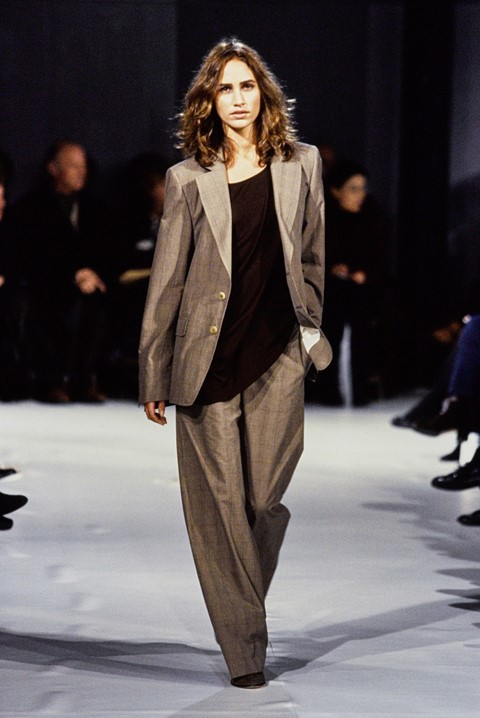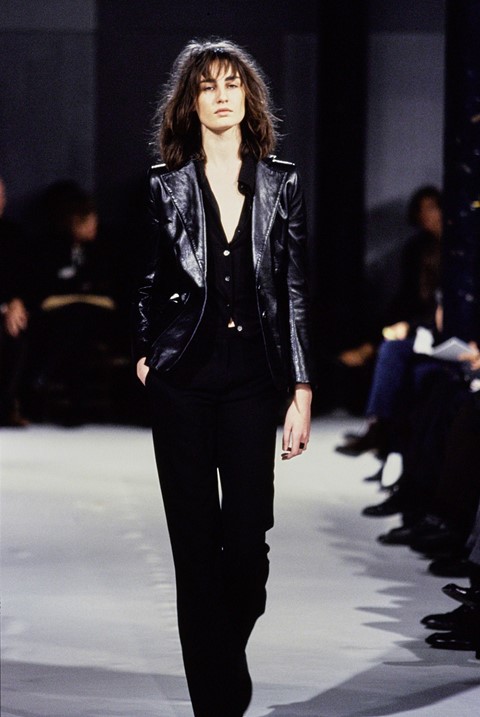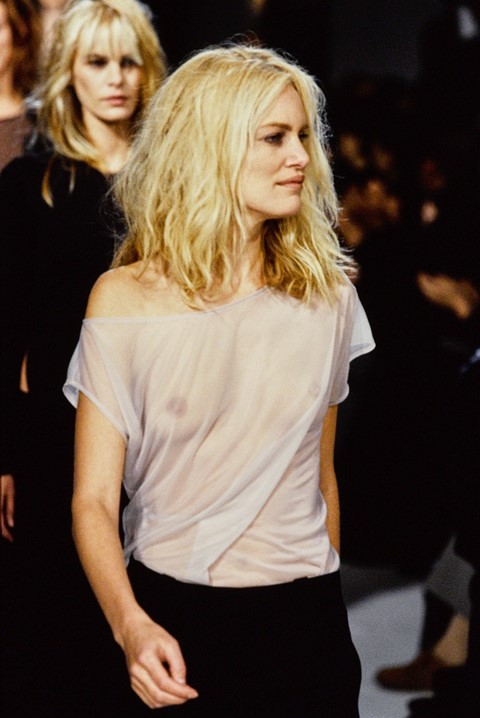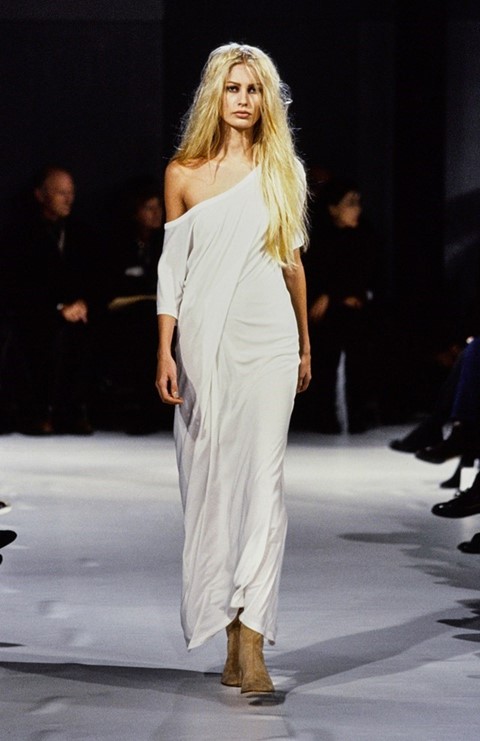A defining moment in the Belgian designer’s career, we recall the show that captivated the fashion industry with a Patti Smith inspired feminine strength
When a group of six Belgian fashion designers rented a van in 1986 and drove to London to show their collections to buyers during London Fashion Week, little did the world know that they would make tidalwaves that would change the course of fashion. They had little in common except their education at Antwerp’s Royal Academy of Fine Arts and each one spun off in different directions. Four went on to make it big: Martin Margiela carved an avant-garde niche in Paris; Dirk Bikkembergs and Dries Van Noten signed licensing deals in Japan and set up ready-to-wear boutiques around Europe. Ann Demeulemeester stayed home and remained fearlessly independent, joining the likes of Jil Sander, Helmut Lang and Miuccia Prada in her status as a go-to designer for urban women in want of real clothes – clothes that included streamlined boyish tailoring, exquisitely cut shirt-soft jackets, slim low-cut trousers and, in a wider sense, clothes that feel discretely romantic, utterly uncontrived and inconspicuously chic. “Ann offered them designer invisibility – her clothes don’t scream status,” observed Vogue. “A Demeulemeester jacket or dress may be unrecognisable from a distance, but up close it has a certain line or attitude that is immediately identifiable. Ann doesn’t want to project an image, so much as tell a story.”

“I want to meet the woman, not the fashion designer who dresses her,” said the designer of her “introverted clothes” in 1997. “I think it’s better for women to be free in that sense. I hate it when everyone looks the same.” Demeulemeester started out by taking her collections to London, before her first show in Paris in a stark art gallery where grungy models wandered down a makeshift runway in androgynous velvet frock coats, hefty high-water trousers and clodhopper shoes. Critics called it funereal. By 1994, she had streamlined her silhouettes and refined her cutting technique to allow for everyday garments with an artfully considered edge. Her chunky-heeled shoes, achieved by carving leather and clay and changing the shape and size over 30 times, were a bestseller at a time when spindly heels prevailed and the popular alternative was Comme des Garçons-esque flat men’s shoes. By 1996, she had a successful menswear line, famous fans and large crowds at her shows. As Vogue observed, the clothes “got sexier” (leather, satin, and dévoré velvet) and the cut got “more adventuresome" (asymmetrical necklines, bias zippers).

The Show
Demeulemeester’s S/S97 show marked the moment that the designer hit her stride and her designs reverberated across fashion in boutiques, offices, studios and museums – the Metropolitan Museum of Art’s Costume Institute even went as far as to acquire pieces from the collection. It came after an unsuccessful collection the previous year, which featured complicated garments that often had just one sleeve – what the designer described herself as “too hard-edged and contrived”. “Designing is like experimenting in public. And I’m not afraid to make mistakes,” she explained. “That collection was too strict. Allez, I thought, I need some air.” She set out create a new silhouette that was counter-current to body-con sex appeal. The models emerged in elegantly nonchalant garments shrugged off one shoulder or were cut to resemble classical drapery that felt sensual and romantic. “At the show, Demeulemeester rocked the fashion pack with pounding decibels of Patti Smith’s Because the Night on the soundtrack, bedroom hair on the models, and reams of clothes exquisitely cut to look like they were falling off in a vampy grunge-meets-gangsta way,” wrote Katherine Betts of the asymmetry-heavy show. “By the end of the show, the crowd that a year before had been panting over Gucci’s fashion equivalent of a one-night stand at Studio 54, was hooked on Ann’s new look of déshabillé glamour.”

The People
Without Patti Smith, there would be no Ann Demeulemeester as we know it. Ann became obsessed with Smith after discovering Horses, Smith’s 1975 album – the one with the Mapplethorpe photo of Smith in a cut-up white shirt and black ribbon. To say that Smith was a major influence on Demeulemeester from that point on would be an understatement, especially considering that the singer’s androgynous, loose-fitted style permeates every one of Demeulemeester’s collections. As a student, Demeulemeester tracked down Smith in Detroit, where she was by then far removed from the punk New York scene she is so commonly associated with, and sent her three white shirts that she had made herself. Smith never forgot it, and the two eventually met and a symbiotic kinship developed. “I derive great power from wearing Ann’s clothes,” wrote Smith in the introduction to Rizzoli’s tome on the designer. “Since I began performing again, after that first gift, I have never gone onstage without wearing a piece by Ann. All of Ann’s clothes are significant: a jacket, a vest, a shirt... they are such a part of me. They make me feel confident, they make me feel truly like myself. They are talismanic.”

The Impact
One of Demeulemeester’s defining qualities, in both her professional and personal life, was her integrity. Refusing to abide by convention, her process was marked by drawing for hours, cutting patterns and designing solutions for her own sartorial dilemmas. At the time of this show, she had no design assistants – explaining that she would rather do it herself than have it done badly. When Givenchy executives came calling the previous spring, she asked a friend “What would I do with all that money?” “Her clothes follow a narrative, which was a problem in the 90s, when designers fell under one extreme influence after another,” wrote The New York Times’ Cathy Horyn in 2006. ‘‘I had the impression, around 1995, that all of a sudden the weather changed,’’ Demeulemeester told Horyn. ‘‘It was all about these big houses. Gucci had started. For me, it was the opposite of freedom. I couldn’t understand.’’

For Demeulemeester, doing anything other than her highly personal, utterly sincere vision of strong femininity was unthinkable – and she remained financially independent and in control of her own brand until her graceful exit from her company in 2013, publicly stated by a handwritten letter. Throughout her career, the hallmarks of her design remained the same – romantic proportions, experimental fabrics, asymmetric and androgynous cuts – and eventually influenced designers that lacked Demeulemeester’s long-time devotion and commitment to such tropes. At a time when most designers sought to increasingly expand and be everywhere in the world, Demeulemeester was perfectly happy in the one she created for herself in Antwerp – and remained in for over two decades.
